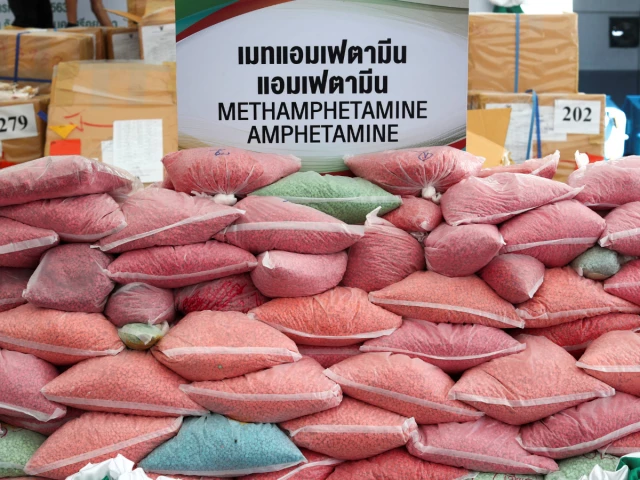As per the latest surveys and reports from global monitoring institutions, the trend in drug and substance abuse is gradually shifting from plant-based drugs (i.e., opium and hashish) to synthetic drugs (methamphetamine, ecstasy tablets, etc.). Methamphetamine, commonly known as meth, is a highly addictive synthetic drug that is increasingly making its footprint in Pakistan. Methamphetamine is a growing health concern not only in Pakistan but for the region and the globe as well. A reported 60% surge in the seizures of methamphetamine in South and West Asia necessitates immediate action against its proliferation. As per UNODC estimates, meth seizures in and around Afghanistan soared from 2.9 tons to 29.7 tons from 2017 to 2021. It is in this backdrop that the vulnerability of Pakistani youth to synthetic drugs, specifically meth, has increased manifold. Unfortunately, meth addiction in Pakistan is steadily rising. The most vulnerable segment of society is the youth, ranging in ages from 18 to 35 years. Educational institutions are the most exposed places, where addicts may range from doctors to engineers, and sportsmen to entrepreneurs.
Soon after taking over Afghanistan in 2021, the Taliban vowed to crack down on narcotics by issuing a decree to ban the production and sale of illicit drugs. However, the decree was not adequately enforced. Notwithstanding the slowdown in 2022 and 2023, the drug trade in Afghanistan began to witness a significant resurgence. According to the UNODC Report 2024, Afghanistan is currently experiencing a 19% increase in cultivation and almost a 30% increase in drug production. The Taliban’s crackdown on poppy cultivation in 2022–23 also instigated a strategic shift toward methamphetamine production.
The surge in meth production in Afghanistan bears dire implications for Pakistan, the region, and the world. Reportedly, scores of meth-manufacturing facilities are operational in Afghan provinces bordering Pakistan. Since 40% of Afghan-origin drugs illegally pass through Pakistan, the infamous heroin-based transit route is also being used as a conduit for the dispatch of synthetic drugs. The inflow of synthetic drugs, particularly meth, from Afghanistan is an imminent threat to Pakistan and its youth.
Three UN treaties together form the international legal framework of the global drug control regime: the Single Convention on Narcotic Drugs, 1961 (as amended by the 1972 Protocol); the Convention on Psychotropic Substances, 1971; and the Convention against Illicit Traffic in Narcotic Drugs and Psychotropic Substances, 1988. Being a signatory to all these international treaties, Pakistan willfully fulfills its obligations.
Domestically, the National Anti-Narcotics Policy 2019 guides the country's counter-narcotics efforts. Pakistan also has comprehensive legislation in the form of the Control of Narcotics Substances (CNS) Act 1997 and the Anti-Narcotics Force Act 1997 to address the legal aspects of its counter-narcotics framework. As a responsible sovereign state, Pakistan maintains zero tolerance towards drug and substance abuse/trafficking and aspires to become a “Drug-Free Nation.” Pakistan has continued to retain and maintain its “Poppy-Free Status” since 2001. During 2024 alone, Pakistan seized over 361 metric tons of drugs, valued at over USD 20 billion in international drug markets. Meth seizures accounted for up to 20 tons — 6% of the total seizures.
With many meth-producing factories operating in Afghanistan, a significant portion of the production is trafficked through Pakistan for onward dispatch to GCC countries and the West. This large-scale trafficking of meth poses a grave threat to Pakistan, which has a sizeable youth population. As both a victim and a transit state, the unintended consequences of meth trafficking include a public health crisis, increased crime and violence, youth entrapment, and strain on law enforcement agencies.
Exploitation of porous borders, misuse of traditional opium routes, and manipulation of the hawala-hundi system contribute to the pilferage of meth from Afghanistan into Pakistan and beyond. Largely, methamphetamine is trafficked alongside heroin, often using children or vulnerable individuals as narco-mules. These are employed along traditional drug trafficking routes into Pakistan. At times, slingshots are used, non-traditional routes are frequented, drones are deployed, camels are used, and fishing boats are hired to evade law enforcement agencies. Moreover, the ease of concealing synthetic drugs and the use of innovative trafficking techniques give traffickers a distinct advantage.
As an addictive stimulant, meth (or “ice”) has the characteristic of keeping a user awake and active for more than 72 consecutive hours. Students in academic disciplines that demand sustained mental focus — such as medicine (MBBS) — are more susceptible to meth/ice use to prolong concentration. This is also true for students preparing for tough competitive exams, who seek to maximize performance in short periods. Ironically, what may begin as occasional use to cope with pressure can quickly evolve into lethal addiction.
Worsening the situation, most drug abuse cases go under-reported due to social stigma and concerns about the academic and professional futures of otherwise capable and ambitious youth. It is therefore necessary to run educational-institution-centric counter-narcotics campaigns across Pakistan more frequently. These campaigns should involve students, parents, faculty, and administrative staff in collaboration with counter-narcotics law enforcement agencies. It must be understood that no single institution alone can address this issue — a whole-of-system and whole-of-nation approach is required to achieve meaningful results.
While plant-based drug crops follow seasonal patterns and require significant land, labor, and logistics, the manufacture of synthetic drugs is a far easier option. Synthetic drugs are made by mixing chemical precursors in cost-effective, controlled environments. Pakistan, being an import-driven economy, brings in various precursors and chemicals to support its industrial needs. The precursors used for legitimate industrial purposes are allocated to registered chemical firms through a quota system regulated by the Ministry of Interior and Narcotics Control (MoI&NC), under a strict multi-tiered process.
However, even the diversion of a small quantity of these chemicals for illicit purposes can result in large-scale synthetic drug production. Such diversions may be concealed under the guise of medicinal or industrial consumption. Hence, the risk of illicit diversion at the sub-distributor or vendor level cannot be ruled out. To curb this trend, it is necessary to digitize the monitoring system and ensure that 100% of firms, dealers, distributors, and vendors dealing in precursors and chemicals are registered with the government and required to furnish complete usage details upon demand.
As a society, our top priority should be to support families and communities in responding more effectively to individuals affected by drug use — particularly meth/ice. We must raise awareness through community engagement programs and treat drug abuse as a collective social challenge. Together, we can make a difference — each of us has a critical role to play to ensure our younger generations remain safe from the menace of drugs.



COMMENTS
Comments are moderated and generally will be posted if they are on-topic and not abusive.
For more information, please see our Comments FAQ